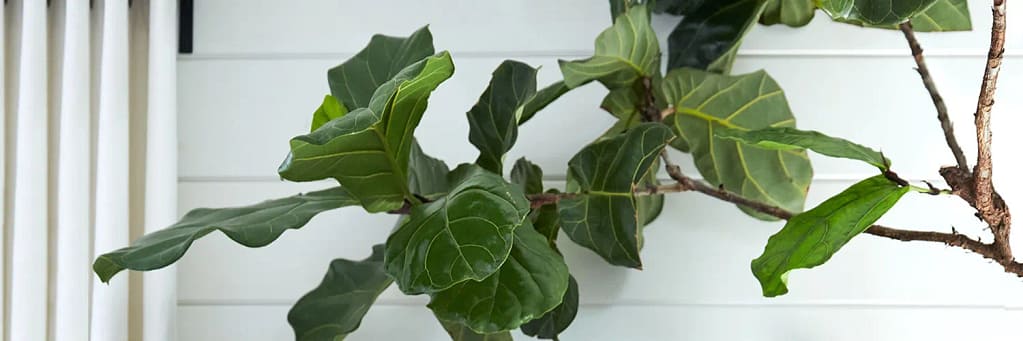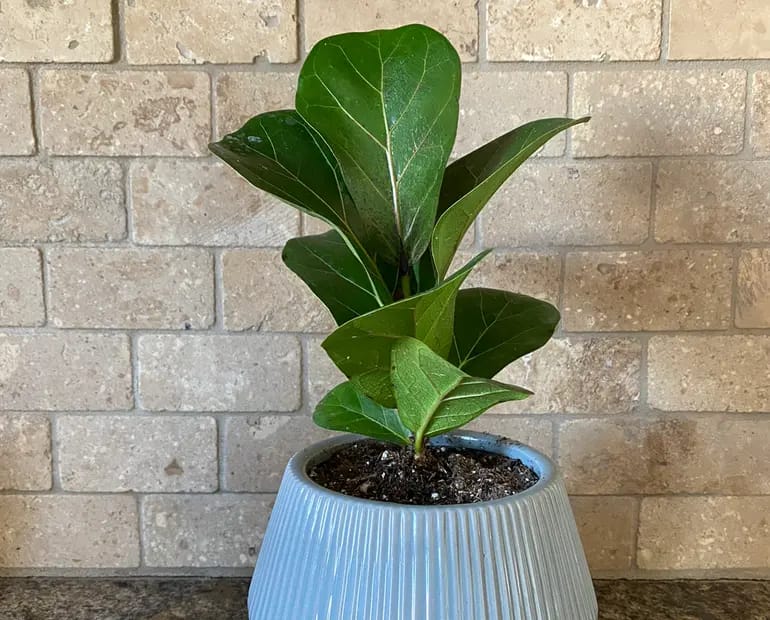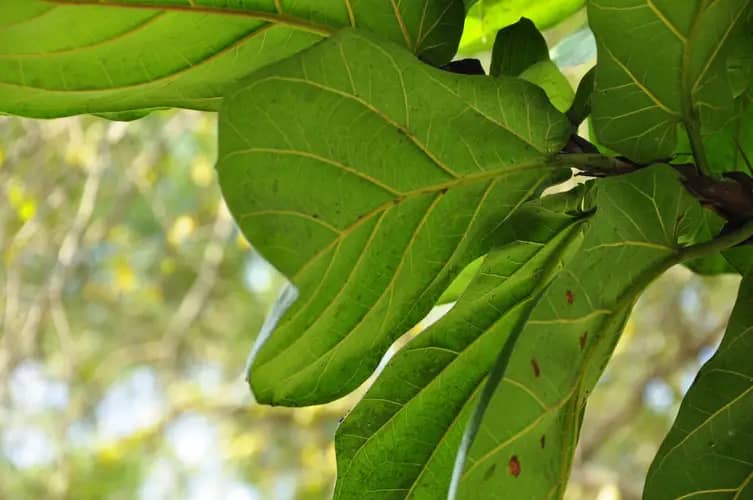Fiddle Leaf Fig (Ficus lyrata) Description
The Fiddle Leaf Fig, scientifically known as Ficus lyrata, is a popular houseplant admired for its striking appearance and large, glossy leaves. Native to the tropical regions of West Africa, this plant is a member of the Moraceae family.
1. Choosing the Right Pot and Soil
- Pot Selection: Select a pot that is 2-4 inches larger in diameter than the root ball of your Fiddle Leaf Fig. Ensure the pot has drainage holes to prevent waterlogging, which can cause root rot.
- Soil Type: Use a well-draining potting mix. A mix formulated for houseplants or one containing peat, perlite, and pine bark works well. Avoid garden soil, as it can compact and retain too much moisture.
2. Preparing the Pot
- Drainage: Place a layer of small stones or a piece of broken pottery at the bottom of the pot to improve drainage.
- Soil Layer: Add a layer of potting mix to the bottom of the pot, enough to position the root ball of the plant so that the top of the root ball sits some inch below the rim of the pot.
3. Planting the Fiddle Leaf Fig
- Removing the Plant: Gently remove the Fiddle Leaf Fig from its nursery pot. If the roots are tightly bound, loosen them slightly with your fingers to encourage growth.
- Placing the Plant: Position the plant in the center of the new pot. Fill around the root ball with potting mix, pressing lightly to eliminate air pockets. Ensure the plant should upright and stable.
- Watering: After planting, water the plant thoroughly until water drains out of the bottom. Its help to settle the soil around the roots.
4. Finding the Right Location
- Light: Place the Fiddle Leaf Fig in a spot with bright, indirect light. Near a north or east-facing window is ideal. Avoid direct afternoon sunlight.
- Temperature: Keep the plant in a room with temperatures between 60-75°F (15-24°C). Avoid placing it near drafts, air conditioning vents, or heating units.
5. Regular Care and Maintenance
- Watering: Water the plant when the surface inch of soil feels dry to the touch. Ensure thorough watering, letting any extra water drain away. During winter when growth slows, decrease the frequency of watering.
- Humidity: Fiddle Leaf Figs thrive in higher humidity. Boost humidity levels by misting the leaves, using a humidifier, or positioning the plant on a humidity tray.
- Fertilizing: Feed the plant with a balanced houseplant fertilizer every 4-6 weeks during the growing season (spring and summer).
- Pruning: Regularly remove any dead or yellowing leaves. Prune the top of the plant to encourage branching and a fuller appearance.
6. Monitoring for Pests and Diseases
- Pests: Check the plant regularly for common pests like spider mites, aphids, and mealybugs. Deal with infestations promptly using insecticidal soap or neem oil.
- Diseases: Watch for signs of root rot, such as yellowing leaves and a musty smell from the soil. Ensure proper watering practices and good drainage to prevent root rot.
1. Light Requirements
- Bright, Indirect Light: Place your Fiddle Leaf Fig near a north or east-facing window where it can receive plenty of bright, indirect sunlight. Direct sunlight, of afternoon scorch the leaves.
- Rotate Regularly: Rotate the plant every few weeks to ensure even growth and prevent the plant from leaning towards the light source.
2. Watering
- Consistent Moisture: Water your Fiddle Leaf Fig when the top inch of soil feels dry to the touch. Water generously until excess water drains from the bottom of the pot.
- Avoid Overwatering: Ensure the pot has drainage holes to prevent water from sitting at the bottom, which can cause root rot. Decrease the frequency of watering during winter when the plant’s growth rate decreases.
3. Humidity and Temperature
- Humidity: Fiddle Leaf Figs prefer higher humidity levels. Increase humidity by misting the leaves regularly, using a humidifier, or placing the plant on a humidity tray.
- Temperature: Keep the plant in a room with temperatures between 60-75°F (15-24°C). Avoid sudden temperature changes and keep it away from drafts, heating vents, and air conditioning units.
4. Fertilizing
- Balanced Fertilizer: Feed your Fiddle Leaf Fig with a balanced, water-soluble houseplant fertilizer every 4-6 weeks during the growing season (spring and summer). Mix the fertilizer at half the recommended concentration.
- No Fertilizing in Winter: Do not fertilize during the winter months when the plant’s growth slows down.
5. Pruning and Cleaning
- Pruning: Regularly trim away any dead or yellowing leaves to keep the plant healthy and attractive. Trim the top of the plant to promote branching and achieve a fuller shape.
- Cleaning Leaves: Dust the leaves regularly with a damp cloth to keep them clean and improve photosynthesis. Clean leaves also help prevent pests.
6. Repotting
- When to Repot: Repot your Fiddle Leaf Fig every 1-2 years, or when it outgrows its current pot. Signs that it needs repotting include roots growing out of the drainage holes or the plant becoming top-heavy.
- How to Repot: Choose a pot that is 2-4 inches larger in diameter than the current pot. Use fresh, well-draining potting mix.
7. Pests and Diseases
- Common Pests: Keep an eye out for common pests such as spider mites, aphids, and mealybugs. Promptly address infestations by using insecticidal soap or neem oil treatments.
- Disease Prevention: Ensure proper watering and good air circulation to prevent diseases like root rot and leaf spot. Remove affected leaves and improve care practices if disease symptoms appear.
8. Supporting Growth
- Staking: If your Fiddle Leaf Fig grows tall and becomes unstable, use a stake to support the stem.
- Training: Train the plant to grow in a specific direction or shape by gently bending and tying the stem or branches.

Scientific and Common Names
- Scientific Name: Ficus lyrata
- Common Names: Fiddle Leaf Fig, Banjo Fig, Fiddle Fig
Where to Plant Fiddle Leaf Fig
Fiddle Leaf Fig can be planted both indoors and outdoors depending on the climate. It thrives in tropical and subtropical regions. Below are some ideal countries and regions for planting Fiddle Leaf Fig:
Indoor Planting
Fiddle Leaf Fig is an excellent indoor plant, especially in regions where the climate is not suitable for year-round outdoor growth. It can be placed in homes, offices, and indoor public spaces.
Outdoor Planting
- United States:
- Southern States: Florida, Texas, Southern California (zones 9-11)
- Hawaii: Ideal due to its tropical climate
- Central America:
- Mexico
- Costa Rica
- Panama
- South America:
- Brazil
- Colombia
- Venezuela
- Caribbean Islands:
- Cuba
- Jamaica
- Dominican Republic
- Africa:
- Nigeria (native region)
- Ghana
- Ivory Coast
- Kenya
- Tanzania
- Asia:
- India (Southern regions)
- Indonesia
- Malaysia
- Thailand
- Philippines
- Australia:
- Northern Queensland
- Northern Territory
Climate Requirements for Outdoor Planting
- Temperature: Prefers warm temperatures between 60-75°F (15-24°C). It cannot tolerate frost and should be protected from cold temperatures.
- Humidity: Thrives in high humidity environments. In dry regions, extra care may be needed to maintain humidity levels.
- Sunlight: Prefers bright, indirect sunlight. In very sunny climates, it should be protected from direct afternoon sun to prevent leaf burn.
Summary
Fiddle Leaf Fig, known scientifically as Ficus lyrata, can be grown indoors in most climates, providing bright, indirect light and consistent moisture. Outdoors, it is best suited for tropical and subtropical regions around the world, including parts of the United States, Central and South America, Africa, Asia, and Australia. Proper care and attention to its light, temperature, and humidity needs will ensure a healthy and thriving plant.

1. Root Rot
Symptoms:
- Yellowing leaves
- Wilting despite adequate watering
- Mushy, dark roots with a foul smell
Causes:
- Overwatering
- Poor drainage
Solutions:
- Improve Drainage: Ensure the pot has adequate drainage holes. Use a well-draining potting mix.
- Adjust Watering: Allow the top inch of soil to dry out between waterings. Water less frequently and ensure excess water drains away.
- Treat Affected Plant: If root rot is suspected, remove the plant from its pot, trim away the affected roots, and repot in fresh, dry soil.
2. Leaf Spot
Symptoms:
- Brown or black spots on leaves
- Yellow halos around spots
Causes:
- Fungal or bacterial infection
- High humidity and poor air circulation
Solutions:
- Improve Air Circulation: Ensure the plant is in a well-ventilated area. Avoid overcrowding with other plants.
- Reduce Humidity: Limit misting and avoid getting leaves wet during watering.
- Remove Affected Leaves: Trim and discard infected leaves. Sterilize pruning tools before and after each use.
- Fungicide Treatment: Apply fungicide as directed by the manufacturer if the issue persists.
3. Edema
Symptoms:
- Small, blister-like bumps on the underside of leaves
- Leaves may become distorted or scarred
Causes:
- Overwatering
- High humidity
Solutions:
- Adjust Watering: Reduce watering frequency and ensure the soil dries out between waterings.
- Improve Air Circulation: Increase ventilation for reduce humidity levels.
4. Mealybugs
Symptoms:
- White, cotton-like masses on leaves and stems
- Sticky residue (honeydew) on leaves
Causes:
- Infestation by mealybugs
Solutions:
- Manual Removal: Wipe affected areas with a cotton swab dipped in rubbing alcohol.
- Insecticidal Soap: Spray the plant with insecticidal soap or neem oil.
- Regular Inspection: Check the plant regularly for signs of pests and treat immediately if found.
5. Spider Mites
Symptoms:
- Fine webbing on leaves and stems
- Yellow, speckled leaves
Causes:
- Infestation by spider mites, often due to dry conditions
Solutions:
- Increase Humidity: Mites thrive in dry conditions, so increasing humidity can help.
- Water Spray Method: Use a forceful stream of water to wash away mites from the plant.
- Insecticidal Soap or Neem Oil: Apply either insecticidal soap or neem oil to the areas affected by mites.
- Isolation: Isolate the affected plant to prevent the spread to other plants.
6. Aphids
Symptoms:
- Tiny green, yellow, or black insects found on leaves and stems
- Sticky residue (honeydew) on leaves
Causes:
- Infestation by aphids
Solutions:
- Manual Removal: Spray the plant with water to dislodge aphids or wipe them off with a damp cloth.
- Insecticidal Soap: Use insecticidal soap or neem oil to treat the infestation.
- Natural Predators: Introduce natural predators like ladybugs if the plant is kept outdoors.
7. Bacterial Leaf Spot
Symptoms:
- Water-soaked lesions that turn brown or black
- Leaves may drop prematurely
Causes:
- Bacterial infection frequently caused by excessive humidity and inadequate air circulation
Solutions:
- Improve Air Circulation: Place the plant in a well-ventilated area and avoid overcrowding.
- Reduce Humidity: Limit misting and avoid wetting the leaves.
- Trim and discard leaves showing signs of infection.
- Copper-Based Fungicide: Apply a copper-based fungicide according to the manufacturer’s instructions if needed.
Preventive Measures
- Proper Watering: Avoid overwatering and ensure the pot has good drainage.
- Cleanliness: Keep the plant and its surroundings clean to prevent pest infestations and infections.
- Healthy Environment: Provide adequate light, proper humidity, and good air circulation.
- Regular Inspections: Check the plant regularly for signs of disease or pests and act promptly if any issues are detected.

